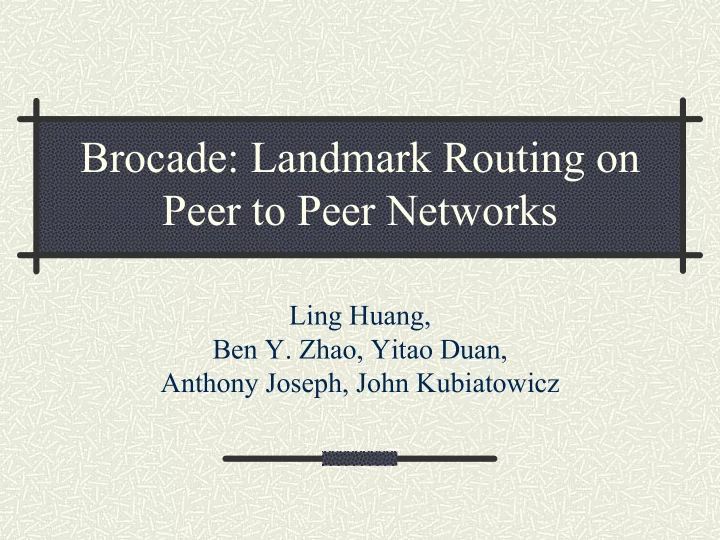

Brocade: Landmark Routing on Peer to Peer Networks Ling Huang, Ben Y. Zhao, Yitao Duan, Anthony Joseph, John Kubiatowicz
State of the Art Routing High dimensionality and coordinate-based P2P routing � Decentralized Object Location and Routing: Tapestry, Pastry, Chord, CAN, etc… � Sub-linear storage and # of overlay hops per route � Properties dependent on random name distribution � Optimized for uniform mesh style networks
Reality � Transit-stub topology, disparate resources per node � Result: Inefficient inter-domain routing (b/w, latency) AS-3 AS-1 S R AS-2 P2P Overlay Network
Talk Outline Motivation Brocade Architecture Brocade Routing Evaluation Summary / Open Questions
Brocade: Landmark Routing Goals � Eliminate unnecessary wide-area hops for inter-domain messages � Eliminate traffic going through high latency, congested stub links � Reduce wide-area bandwidth utilization � Maintain interface: RouteToID ( globally unique ID)
Brocade Architecture Brocade Layer Original Route Brocade Route AS-3 AS-1 S R AS-2 P2P Network
Mechanisms Intuition: route quickly to destination domain � Organize group of supernodes into secondary overlay � Sender (S) sends message to local supernode SN1 � SN1 finds and routes message to supernode SN2 near receiver R � SN1 uses Tapestry object location to find SN2 � SN2 sends message to R via normal routing
AS-1 S Classifying Traffic Brocade not useful for intra-domain messages P2P layer should exploit some locality (Tapestry) � Undesirable processing overhead � Classifying traffic by destination Proximity caches : � Every node keeps list of nodes it knows to be local Need not be optimal, worst case: 1 relay through SN Cover set: � Supernode keeps list of all nodes in its domain. Acts as authority on local vs. distant traffic
Entering the Brocade Route: Sender � Supernode (Sender)? IP Snooping brocade � Supernode listens on P2P headers and redirects � Use machines close to border gateways +: Transparent to sender –: may touch local nodes Directed brocade � Sender sends message directly to supernode � Sender locates supernode via DNS resolution: nslookup supernode.cs.berkeley.edu +: maximum performance –: state maintenance
Inter-supernode Routing Route: Supernode (sender) � Supernode (receiver) � Locate receiver’s supernode given destination nodeID � Use Tapestry object location Tapestry � Routing mesh w/ built in proximity metrics � Location exploits locality (finds closer objects faster) Finding supernodes � Supernode “publishes” cover set on brocade layer as locally stored objects � To route to node N , locate server on brocade storing N
Feasibility Analysis Some numbers � Internet: ~ 220M hosts, 20K AS’s, ~10K nodes/AS � Java implementation of Tapestry on PIII 800: ~1000 msgs/second State maintenance � AS of 10K nodes, assume 10% enter/leave every minute � Only ~1.7*5 � 9% of CPU spent processing publish on Brocade � If inter-supernode traffic takes X ms, Publishing takes 5 X � Bandwidth: 1K/msg * 1K msg/min = 1MB/min = 160kb/s Storage requirement of Tapestry � 20K AS’s, Octal Tapestry, Log 8 (20K 2 ) = 10 digits � 10K objects (Tapestry GUIDs) published per supernode � Tapestry GUID = 160 bits = 20B � Expected storage per SN: 10 * 10K * 20B = 2MB
Evaluation: Routing RDP Brocade Latency RDP 3:1 Original Tapestry IP Snooping Brocade Directed Brocade Optimal IP 5 4.5 Relative Delay Penalty 4 3.5 3 2.5 2 1.5 1 0.5 0 2 4 6 8 10 12 14 16 18 20 22 24 26 Optimal Route Distance (Hops) Local proximity cache on; inter-domain:intra-domain = 3:1 Packet simulator, GT-ITM 4096 T, 16 SN, CPU overhead = 1
Evaluation: Bandwidth Usage Brocade Aggregate Bandwidth Usage Original Tapestry IP Snooping Brocade Directed Brocade Minimum Bandwidth 60 Bandwidth per Message 50 40 30 20 10 0 2 4 6 8 10 12 14 Distance of Shortest Path Between Endpoints (Hops) Local proximity cache on Bandwidth unit: (SizeOf(Msg) * Hops)
Brocade Summary P2P systems assume uniformity � Extraneous hops through backbone to domains � Routing across congested stubs links Constrain inter-domain routing � Remove unnecessary routing through stubs � Reduce expected inter-domain hops � Limit misdirection in less congested backbone Result: lower latency, less bandwidth utilization
Ongoing Questions Performance at what cost? � Keep virtualization and level of indirection, named routing � May lose some fault-tolerance (how much?) Making P2P real � Deployment issues? � Impact of BGP routing policies on performance? Future/ongoing work � Fault-tolerant supernodes � Finer-grain node differentiation? � Brocade as replacement for BGP? { ravenben, hling }@eecs.berkeley.edu HTTP://www.cs.berkeley.edu/~ravenben/tapestry
Recommend
More recommend